The “Medical Mysteries” series is proving to be quite a money maker for ABC. The New York Daily News reports:
It’s been a challenging summer for the usually dominant ABC. How tough? Reality offerings have crashed and burned. Few are watching reruns of “Lost,” “Grey’s Anatomy” and “Desperate Housewives.” But things are looking up. ABC News’ “Medical Mysteries” series, which examines bizarre medical conditions, has turned out to be a real crowd- pleaser.
So it’s not surprising that they would continue to promote the series, and as part of this promotion offer up a preview story on their ABC “news” site, right next to the wolfman, the echolocating blind men, and the women who smell like dead fish.
The ABC Story features Morgellons Patients: Brandi Koch, Anne Dill, Greg Smith and also Mary Leitao, the founder of the MRF, and her son, Drew.
Leitao’s part in the story is interesting, since it explains the start of the Morgellons phenomenon:
Armed with research, Leitao took her son to a doctor at one of the country’s leading hospitals. He dismissed her tale of fibers and wrote to her pediatrician, saying that her son needed Vaseline for his lips and that his mother needed a thorough psychiatric evaluation.
well, you would think that the next logical step in the story would be to explain how she found her son’s fibers were not normal, and disproved all the doctors, but no, we get:
Undaunted, Leitao began poring through the medical literature looking for clues. What she discovered was a 17th-century reference to a strange disease with “harsh hairs” called “morgellons.”
A disease where infants have a fever, and then you rub milk on them, hairs spring from their backs, which you pluck, and the fever vanishes. Nothing to do with anything. Why do they keep bringing this up?
What does Mary say about Drew’s fibers:
“What I saw were bundles of fibers, balls of fibers,” Leitao says. “There was red and blue.” Even stranger, they glowed under ultraviolet light.
I have explained red and blue fibers before. I’ve also explained the glowing (although that’s usually white fibers, which Mary also found, just did not mention in this story). I’ve even discussed the fibers emerging from his lip. There is no evidence at all that Drew had anything at all unusual going on.
Now here’s something I’m looking forward to seeing:
Dr. Greg Smith of Gainesville, Ga., has been a pediatrician for the past 28 years. He claims a fiber is coming out of his big toe, and he has video footage to prove it.
Video footage of fibers emerging is something I’ve been suggesting for a while. The fibers are the only really interesting thing about “this disease” for which you might have a chance of getting some evidence.
The rest of the article is similar to other media articles. Anne Dill (who has a very impressive photo gallery) says her husband died of Morgellons, but he was actually diagnosed with ALS. 4500 people are supposed to have contacted Leitao, when all they did was fill in an internet survey. A doctor says that the lesions form when people scratch themselves.But the real news, and what I suspect that MRF were so excited about before they collapsed, is that the Tulsa City police department were unable to identify some fibers collected from a Morgellons Patient by Randy Wymore:
Forensic scientist Ron Pogue at the Tulsa Police Crime Lab in Oklahoma checked a morgellons sample against known fibers in the FBI’s national database. “No, no match at all. So this is some strange stuff,” Pogue says. He thinks the skeptics are wrong. “This isn’t lint. This is not a commercial fiber. It’s not.”
The lab’s director, Mark Boese, says the fibers are “consistent with something that the body may be producing.” He adds, “These fibers cannot be manmade and do not come from a plant. This could be a byproduct of a biological organism.”
What kind of obscure biological organism produces fibers? Bombyx mori? Rodentia Chinchillidae? Ovis aries? Exactly how extensive is this FBI national database, and how do you check a sample against it? Here’s an earlier mention of the involvement of the Tulsa Police:
The fibers, about the size of small eyebrow hairs, are not living organisms, Dr. Wymore decides. He teams with a Tulsa police department crime lab to sort through fiber samples, and though the lab owns a database of more than 800 fibers, these fibers match nothing.
800 fibers does not sound like very many to me. I bet they don’t have this one: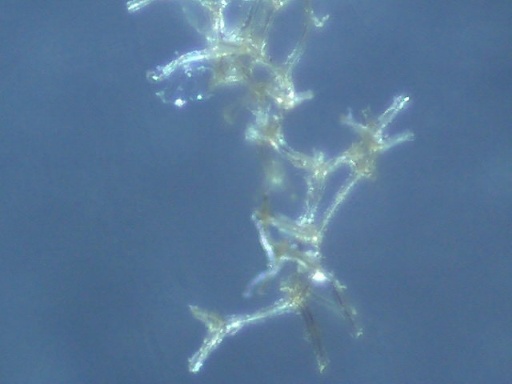
or this one:
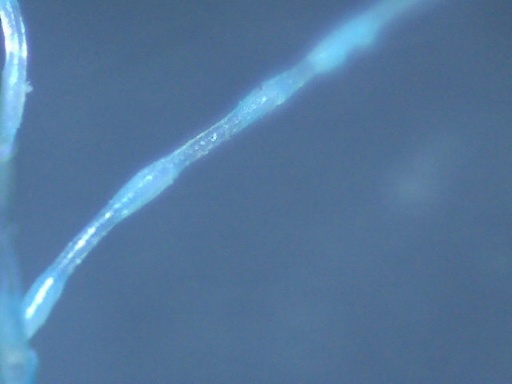
I’ve got more. My point is that 800 fibers might cover 90% of the common household fibers found in your average bit of lint, but there’s still probably over 10,000 other uncommon fibers like the above – lots of room for unidentified fibers. (A prize to the first person to correctly identify the above two photos – they are from a QX5 at 60x, so are about 3mm across).
Here’s a natural man-made fiber (the large one on the bottom right):
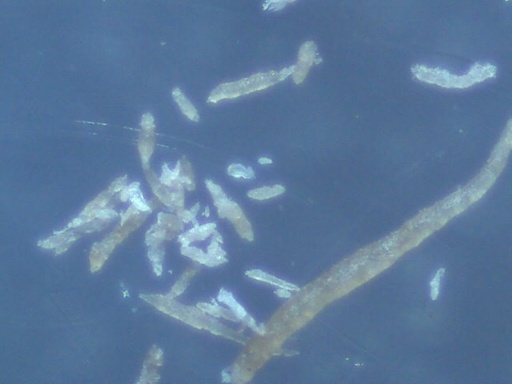
I KNOW they don’t have that one in their fiber database. Why? I made it myself, simply by firmly rubbing my upper arm with a fingertip after having a hot shower. Some old sun-dried skin sloughed off, and rolled up with natural skin oil and sebum, forming this fiber-like shape. Everyone has these “fibers” from time to time, not everyone really looks at them with a microscope, or asks the police to identify them.
Here’s a much better article on Morgellons, from the Associated Press:
http://www.mercurynews.com/mld/mercurynews/living/health/15227993.htm
He recruited two Oklahoma State faculty physicians. They tweezed fibers from beneath the skin of some Morgellons patients who visited the Oklahoma State Center for Health Sciences in Tulsa in February, Wymore said, and sent those samples to the Tulsa Police Department’s forensic laboratory.
The police checked the samples against carpet and clothing fibers and other materials, and conducted chemical analyses and other tests. Nothing matched, said Mark Boese, the police lab’s director.
“How it is being produced, I don’t know,” Boese said. He theorized the fibers could be produced by human hair follicles that somehow encapsulated pollutants processed by the body.
I’ve nothing against the Tulsa Police forensic department (although they do seem to be big fans of CSI). But again, all they have said is they cannot identify some fibers, and they don’t think they are man-made or plant fibers. Hopefully more information will be forthcoming, but they have not explained how they have scientifically determined they are “some strange stuff”. What tests were run? What were the results of the tests? The Tulsa police has some nice equipment. Were these tests run with public money? Can we have the results?
Maybe we’ll see more more details on the show. But remember, ABC is here to entertain you, their aim is to build market share. Keep that in mind, when weighing their evidence. Is it possible that there is some less entertaining evidence? How many fibers were looked at? How many of those fibers were simply not entertaining enough?
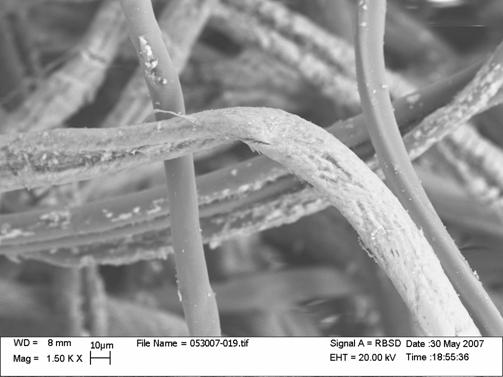
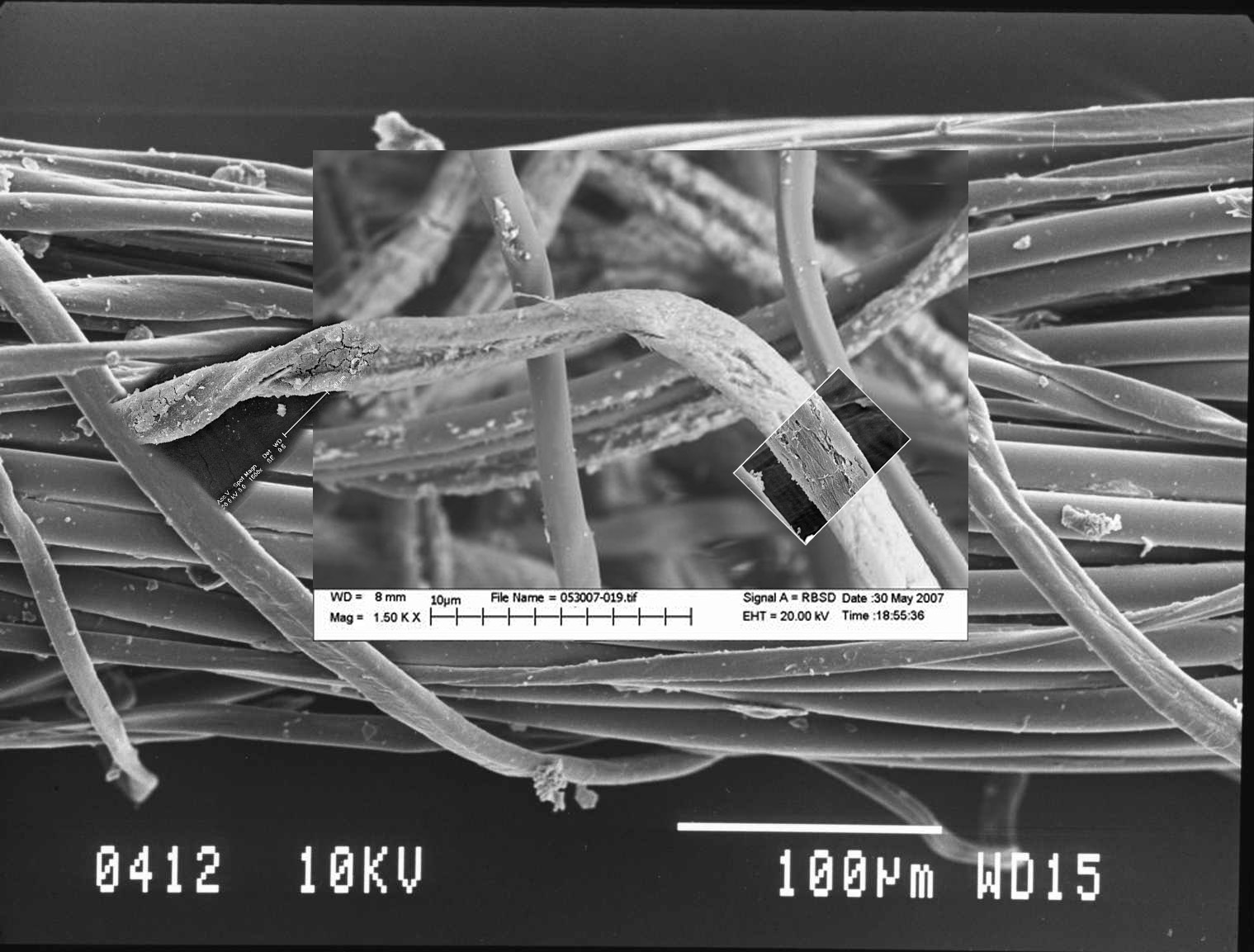




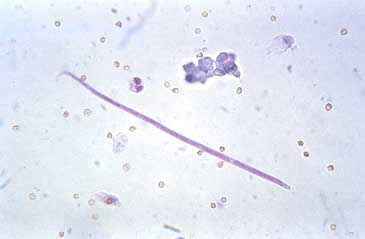 It seems like someone at the MRF was a little over-eager to share their new theory with the world. Yesterday the MRF web site was suddenly changed from cautious suggestion that Morgellons is related to Lyme disease, to wide ranging speculation of animal worms and rare bacterial infections. These new theories are rather out of keeping with the prior tone of the MRF, and this make me wonder if a new hand is at the helm.
It seems like someone at the MRF was a little over-eager to share their new theory with the world. Yesterday the MRF web site was suddenly changed from cautious suggestion that Morgellons is related to Lyme disease, to wide ranging speculation of animal worms and rare bacterial infections. These new theories are rather out of keeping with the prior tone of the MRF, and this make me wonder if a new hand is at the helm.


